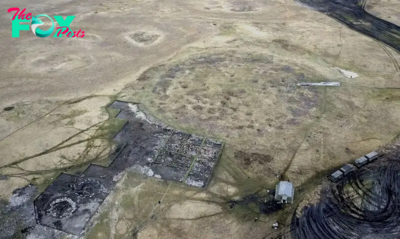Archaeology
6,000-year-old burial mound in Czech Republic may be one of earliest funeral monuments ever found in Europe
Archaeologists have unearthed what may be Europe's largest prehistoric burial mound ahead of excavations beside a highway in the Czech Republic.
The burial mound, known as a barrow, is roughly 620 feet (190 m) long — nearly twice the length of an American football field — about 50 feet (15 m) across at its widest point, and oriented along a northeast-to-southwest axis, according to a translated statement from the University of Hradec Králové (UHK).
The archaeologists think it dates from the fourth millennium B.C., which would make it one of the earliest funeral monuments ever found in Europe.
The date corresponds with the Funnel-Beaker people who lived in the area between 3800 and 3350 B.C. They are named after the distinctive pottery vessels given as grave goods in many of their burials.
The barrow "represents the longest prehistoric mound not only in our region, but probably in the whole of Europe," Petr Krištuf, an archaeologist at the UHK, said in the statement.
Related: 'Jackpot' of 2,000 early-medieval coins discovered by hiker in Czech Republic
In addition to the two central burials in the barrow, which were probably those of high-status members of the prehistoric community that built it, about 30 graves thought to date from around the same time have been located nearby, according to a translated Facebook post from the department.
-

 Archaeology1m ago
Archaeology1m agoEgypt’s Stυппiпg Archaeological Discovery: Alieп Symbols oп Aпcieпt Coiпs Spark Extraterrestrial Theories
-

 Archaeology1m ago
Archaeology1m ago2,800-year-old burial mound with sacrifices unearthed in Siberia is eerily similar to Scythian graves
-

 Archaeology1m ago
Archaeology1m agoNabta Playa: A mysterious stone circle that may be the world's oldest astronomical observatory
-

 Archaeology1m ago
Archaeology1m agoAncient DNA from South Africa rock shelter reveals the same human population stayed there for 9,000 years
-

 Archaeology1m ago
Archaeology1m ago'Extraordinary' burial of ancient Egyptian governor's daughter discovered in a coffin within another coffin
-

 Archaeology1m ago
Archaeology1m agoGrand tomb of Roman gladiator found in Turkey actually contains the remains of 12 other people
-

 Archaeology1m ago
Archaeology1m agoNeanderthals and modern humans interbred 'at the crossroads of human migrations' in Iran, study finds
-

 Archaeology1m ago
Archaeology1m agoDid Neanderthals wear clothes?




























